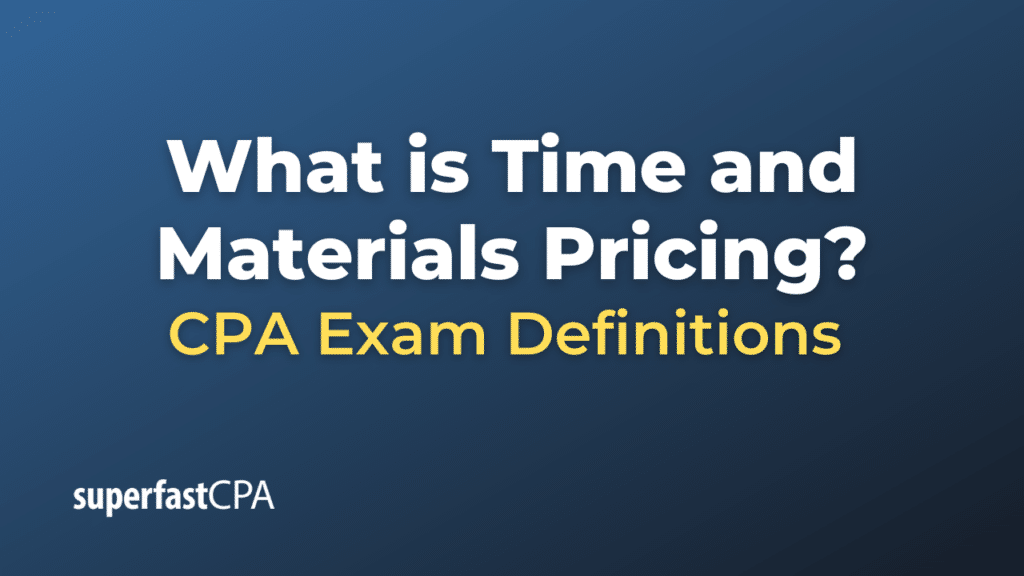Time and Materials Pricing
Time and Materials (T&M) pricing, often used in consulting, freelancing, and contracting, refers to a pricing structure where customers pay for the actual time spent by the service provider (often at a pre-defined hourly or daily rate) as well as the materials or other direct costs incurred as part of the project or task. This approach contrasts with fixed-price contracts where the price is set regardless of the time or resources used.
Key components of Time and Materials pricing include:
- Time: This relates to the hours worked by the service provider. The hourly rate can vary based on the skills, experience, and expertise of the individual. Some T&M contracts might have different rates for different activities or individuals. For example, a senior consultant might have a higher rate than a junior one.
- Materials: These are the actual expenses incurred for the materials used in the project. It can include software, hardware, office supplies, or any other resources. Some contracts may also include other direct expenses such as travel, meals, or accommodation if they are related to the project.
Advantages of T&M Pricing:
- Flexibility: Both the client and service provider have the flexibility to adapt to changes without the need to renegotiate the entire contract.
- Transparency: Clients can see exactly where their money is going, be it in terms of man-hours or materials.
- Fairness: Service providers are paid for all the work they do and the resources they use.
Disadvantages:
- Uncertainty: The final cost might be uncertain at the start of the project, which can be a challenge for clients with fixed budgets.
- Monitoring: Requires meticulous tracking and documentation of hours and costs to ensure accuracy and transparency.
- Potential for Abuse: Without proper oversight, there’s a risk that projects can become prolonged to bill more hours.
Example of Time and Materials Pricing
Let’s consider a real-world example involving a home renovation to illustrate the Time and Materials (T&M) pricing model:
Scenario: Imagine that Emily hires a contractor, Mike, to renovate her kitchen. After inspecting the kitchen, Mike suggests using a T&M pricing model because there are uncertainties related to the age of the house, and unforeseen challenges may arise during the renovation.
Agreement Terms:
- Time:
- Carpenter’s rate: $30/hour
- Electrician’s rate: $40/hour
- Plumber’s rate: $35/hour
- Materials: Mike will provide receipts for all materials purchased.
Project Execution:
Over the course of the renovation:
- The carpenter works 50 hours.
- The electrician works 10 hours because while installing new lighting, he discovers outdated wiring that needs updating.
- The plumber works 15 hours, installing a new sink and dishwasher.
Additionally, Mike buys the following materials:
- Lumber: $500
- Electrical supplies (wiring, outlets, etc.): $150
- Plumbing supplies (pipes, faucets, etc.): $200
- Paint and brushes: $100
Cost Calculation:
- Time:
- Carpenter: 50 hours x $30/hour = $1,500
- Electrician: 10 hours x $40/hour = $400
- Plumber: 15 hours x $35/hour = $525
Total for labor = $1,500 + $400 + $525 = $2,425
- Materials:
Total for materials = $500 + $150 + $200 + $100 = $950
Total Project Cost:
= Labor + Materials
= $2,425 + $950
= $3,375
So, Emily owes Mike $3,375 for the kitchen renovation based on the Time and Materials pricing model.
It’s important to note that with T&M, while Emily didn’t have a fixed price at the start, she only paid for the actual work done and materials used. This arrangement provided flexibility to manage unforeseen challenges but required trust and transparency between both parties.














